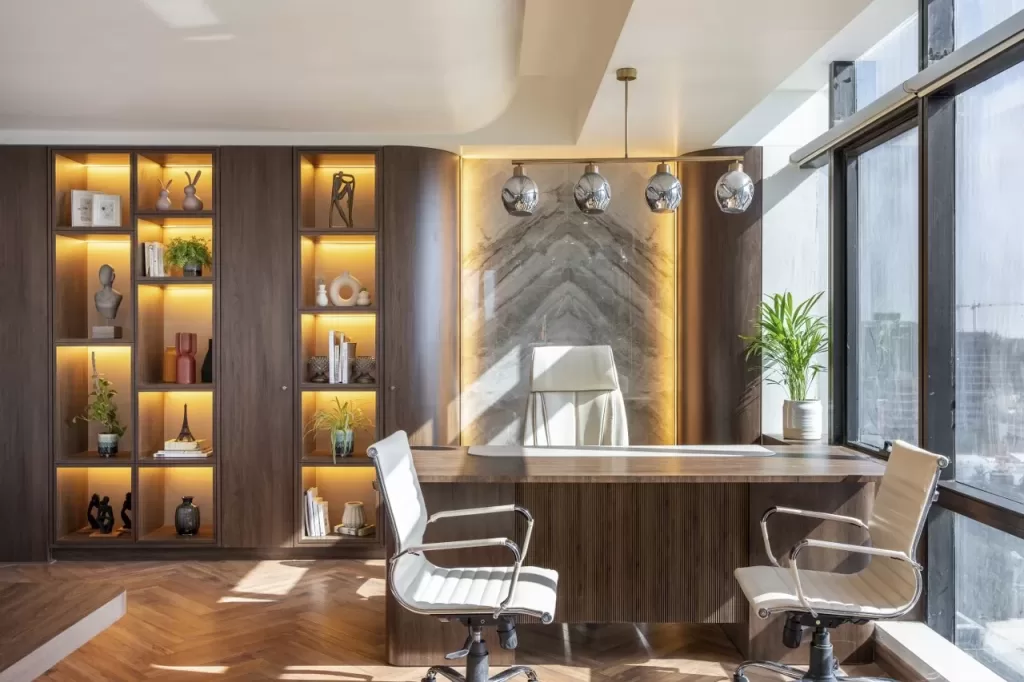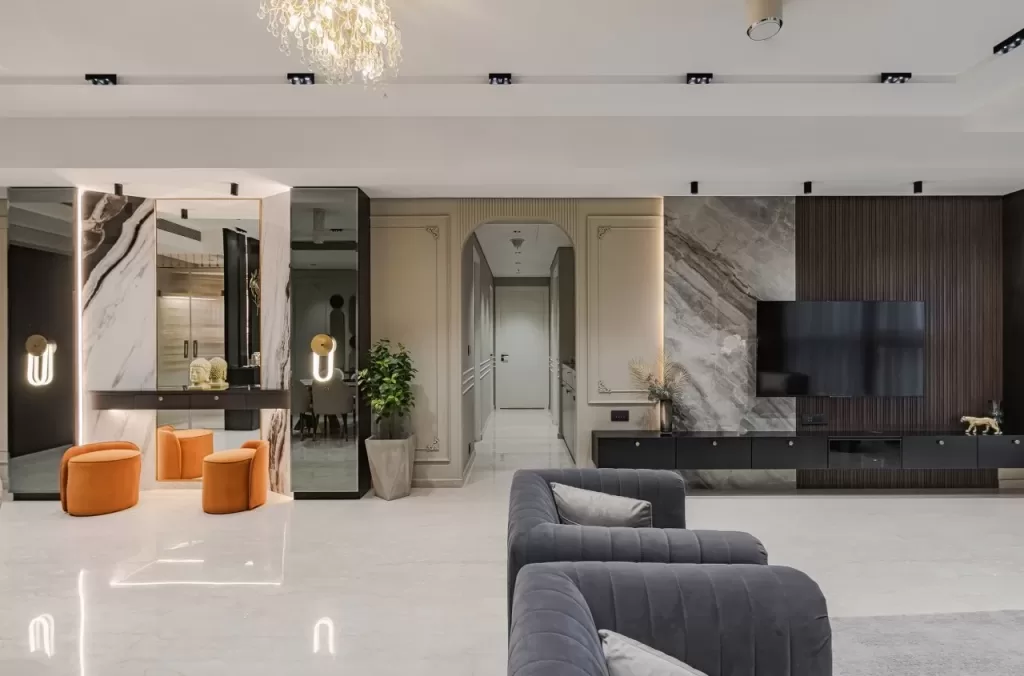12 Feb How to make a room feel bigger: 15 ideas to open up your rooms
How to make a room feel bigger, is very essential for interior designers or architects to learn; the challenge of transforming a confined space into an expansive haven is both an art and a science. In the intricate dance between aesthetics and functionality, our living spaces often bear the challenge of feeling confined. Whether dealing with limited square footage or simply seeking to create an airier atmosphere, the art of making a room feel more extensive lies in the details. For example, if it is a cosy apartment, a small bedroom, or any space that feels a bit snug, the key lies in strategic design choices and working on physical boundaries. Read further to learn some tips on how to make a room feel bigger.
1. Light Colours

Choose light hues for walls and furniture to enhance brightness, creating an airy ambiance that visually expands the room and promotes a sense of openness, perfect for smaller spaces. Light colours, such as timeless whites, soft neutrals, or pastel shades, are a foundational approach to creating a spacious feel. Consider extending the light colour scheme to flooring and incorporating reflective surfaces for added luminosity.
2. Maximize Natural Light

Maximising natural light is crucial for creating an open and inviting space. Begin by opting for sheer or light-filtering window treatments that allow sunlight to penetrate while maintaining privacy. Minimise heavy or dark-coloured curtains, choosing lighter options to enhance the diffusion of sunlight. Keep windows clean and unobstructed to maximise light intake, ensuring your interior benefits from the full spectrum of daylight for a brighter and more expansive ambiance.
3. Strategic Mirrors or Reflective Surfaces

Employ mirrors strategically to reflect light and visually amplify space, creating the illusion of depth and openness while also serving as stylish decor elements that enhance the room’s aesthetic appeal. Incorporate furniture or decor with reflective surfaces in light colours, such as mirrored or metallic finishes. These surfaces enhance the reflective properties of light colours, contributing to a spacious feel.
4. Clear Furniture

Choose furniture with legs or transparent materials to maintain a sense of openness, allowing light to pass through and reducing visual weight, creating the illusion of more space in the room. Opt for furniture with a visually lightweight appearance, featuring slender frames and open designs, to prevent a cramped feeling and maintain an overall sense of openness.
5. Use Vertical Space

Efficiently utilising vertical space is key to optimising room functionality and creating the illusion of increased height. Maximise vertical space with tall shelves or wall-mounted storage solutions, drawing the eye upward. Another example is the use of vertical artwork or decor elements that can emphasise height, creating a more dynamic visual experience in the room.
6. Open Shelving

Opt for open shelving instead of closed cabinets to showcase items without adding visual weight, contributing to an open feel while also allowing for easy access. They also allow light to penetrate freely, contributing to a brighter ambiance. A strategic arrangement of items on open shelves can maintain an organised appearance, offering both functionality and an airy feel to the room.
7. Limit Patterns

Minimise the use of busy patterns to prevent visual clutter, creating a more serene and spacious environment and allowing for a cleaner aesthetic that contributes to the perception of a larger and more open room. Opt for solid colours or subtle textures to maintain a clean and cohesive look. If patterns are desired, use them sparingly, perhaps as accent pieces or in small doses, ensuring they complement rather than dominate the visual landscape.
8. Hang Curtains High

Install curtains close to the ceiling to draw the eye upward, giving the illusion of higher ceilings and making the room feel more spacious. This elongates the visual lines of the room, making it appear more expansive. Choose curtains that extend to the floor, further emphasising vertical lines. The combination of elevated curtain placement and longer lengths contributes to an elegant and open aesthetic.
9. Choose Low Furniture

Opt for lower-profile furniture to maintain an open sightline, allowing the eye to travel freely across the room and creating a more expansive feeling. Low furniture pieces, such as sofas, coffee tables, and chairs, create unobstructed sightlines and allow more visual space above them. This design principle not only contributes to an airy ambiance but also imparts a modern and streamlined view.
10. Multipurpose Furniture

Invest in furniture that serves multiple functions, such as a sofa bed or a coffee table with storage, maximizing utility without compromising space. Integrate foldable or collapsible furniture items that can be tucked away when not in use, freeing up space and providing flexibility in the room’s layout.
11. Consistent Flooring

Choosing consistent flooring throughout a space is a powerful design strategy to create a seamless and expansive feel. Whether it is hardwood, tile, or another material, uniform flooring visually connects different areas, eliminating abrupt transitions that can make a room feel smaller. Consistent flooring enhances the overall flow and continuity, allowing the eye to move freely without interruption.
12. Declutter

Decluttering is a fundamental step in making a room feel more spacious and inviting. Streamlining possessions and keeping surfaces clear create an organised and open atmosphere. Utilise storage solutions to hide away necessities and regularly purge unnecessary items. This minimalist approach not only maximises usable space but also fosters a sense of cleanliness, contributing to the overall perception of a larger room.
13. Monochromatic Colour Scheme

This approach creates a cohesive and harmonious look, eliminating visual distractions and contributing to a more spacious feel. By sticking to one colour family, the room gains a unified and balanced aesthetic. This design choice allows for a seamless flow of colour. Additionally, incorporating different textures and patterns within the chosen colour palette adds depth and visual interest to maintain a dynamic and inviting atmosphere.
14. Create Focal Points

By creating intentional areas of interest, you guide the eye and add visual depth. This can be achieved through bold artwork, a standout piece of furniture, or an architectural feature. The focal point becomes a captivating center piece, diverting attention from the room’s dimensions and enhancing the overall perception of space by offering visual engagement and interest.
15. Add Vertical Stripes

Incorporating vertical stripes in your room design is a clever technique to create a visual illusion of height and spaciousness. Whether in wallpaper, paint, or decor, vertical stripes draw the eye upward, making the walls appear taller. This effect contributes to an elongated perception of the space, creating a more expansive and open atmosphere. Choosing subtle and neutral stripe patterns can add sophistication without overwhelming the room, maintaining a balanced and visually pleasing environment.
Conclusion
How to make a room feel bigger, the transformative power lies in thoughtful design choices. From the choice of light colours to the strategic use of vertical space and the magic of light, each tip plays a crucial role in redefining the perception of space within our homes. Remember, the journey of how to make a room feel bigger is not just about the area; it’s about embracing creativity, maximising potential, and curating a harmonious environment. By incorporating these insights into your design, you’re well-equipped to unlock the full potential of your living spaces, creating a home that not only looks more spacious but feels like a true sanctuary.
Content Writing And Research By: Ar. Ishita Jindal
The post How to make a room feel bigger: 15 ideas to open up your rooms appeared first on The Architects Diary.




No Comments